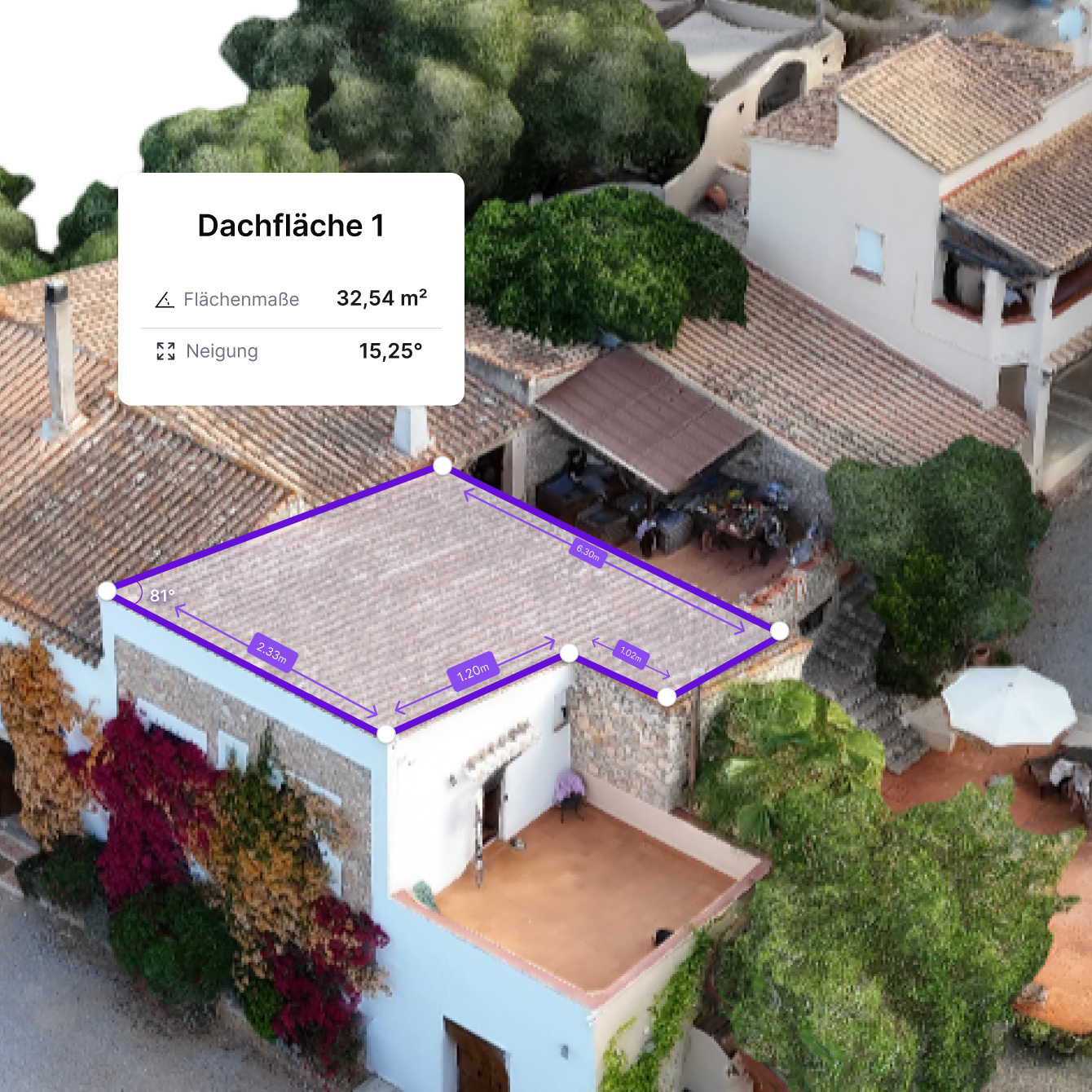Photogrammetry: Digital building measurement simply explained

How can you measure an entire house with millimetre accuracy — without a tape measure or building plans? The answer lies in technology that works with simple photos and creates a precise 3D model from them. Discover how photogrammetry is revolutionizing home construction and renovation.
What is photogrammetry?
Photogrammetry is a method for digitally measuring objects using photos. From several overlapping images, a precise 3D model is created that makes dimensions, surfaces and structures visible. It is ideal for planning PV systems, heat pumps or home renovations.
How does photogrammetry work?
Photogrammetry works by taking several overlapping photos of an object from different perspectives and converting them into a 3D model using special software. This results in precise measurement values and geometric structures from image data.
When surveying buildings, the roof, façade or plot of land are photographed. The software recognizes distinctive points, creates a point cloud and generates a scale-based 3D model for further planning.
What are the benefits of photogrammetry for craftsmen?
Photogrammetry offers craft businesses an efficient way to digitally record buildings and land. As a result, manual measurement on site is no longer necessary. This provides the following benefits:
- Time saving: No on-site appointment required, photos are sufficient for an exact measurement.
- Exact database: 3D models accurate to the millimetre for planning, offering and implementation.
- Cost efficiency: Fewer trips, less effort, faster project execution.
- Better customer communication: Visualizations help with advice and preparation of offers.
- compatibility: Data can be further processed using CAD, PV or heat load software.
- documentation: Ideal for recording existing buildings or for later proofs.
Application examples: Where is photogrammetry used?
Photogrammetry is used in crafts in particular where buildings need to be precisely measured and digitally documented. Typical examples of applications in the craft sector are:
- Roof measurement for photovoltaic systems
- Façade mount for planning thermal insulation or window replacement
- Land measurement when annexed or on a hillside
- Building digitization for heat load calculation or renovation concepts
- Documentation of existing buildings before and after renovations
Other areas of application outside the craft sector:
- Architecture and monument preservation to record historic buildings
- Construction industry for construction progress documentation
- Agriculture for terrain analysis or irrigation planning
- Geography and cartography to create elevation models and maps
- Forensics and accident analysis to reconstruct scenes
How much does photogrammetry cost?
The costs for a photogrammetry survey start at around 350 euros for simple roof photos. Larger projects with a façade or terrain profile cost between 500 and 1,000 euros. The price depends on the object, the desired level of detail and the further processing of the data.
What are the three types of photogrammetry?
There are three types of photogrammetry: aerial photogrammetry, terrestrial photogrammetry, and close-range photogrammetry. Aerial photogrammetry uses drones or airplanes, terrestrial photogrammetry is used from the ground, and close-range photogrammetry is used for smaller objects or building details — often with a camera or smartphone.
How accurate is photogrammetry?
Photogrammetry provides very high accuracy — down to a few millimeters, depending on photo quality and software. It is usually completely sufficient for roof and façade measurements. Through professional evaluation, exact dimensions, areas and structures can be reliably recorded.
How many photos do you need for photogrammetry?
Reliable photogrammetry usually requires 30 to 100 overlapping photos — depending on object size and complexity. It is important that all areas are recorded from multiple perspectives so that the software can calculate a seamless 3D model.
Which is better, photogrammetry or lidar scan?
Whether photogrammetry or LiDAR is more suitable depends on the intended use. Photogrammetry provides detailed 3D models based on photos and is ideal for roof and façade measurement. LiDAR scans capture geometry particularly precisely and are advantageous for complex interiors.
At autarc, we use Photogrammetry targeted for PV planning one. They carry out the drone flight, capture the roof and upload the images. You will then receive a 3D model. This is particularly helpful for hard-to-reach or steep roofs.
For heating planning, for example to calculate heat load or identify radiators, we use the LiDAR scan. This allows room sizes, window areas and building structures to be measured with millimetre accuracy.
Digitize your processes with autarc
Do you install heating systems, PV systems, battery storage systems or wallboxes? With autarc, you can carry out acquisition, planning, promotion, maintenance and customer communication in one software. Make your company fit for the future. Register now and test it free of charge for 14 days.
%25203%2520(1).webp)